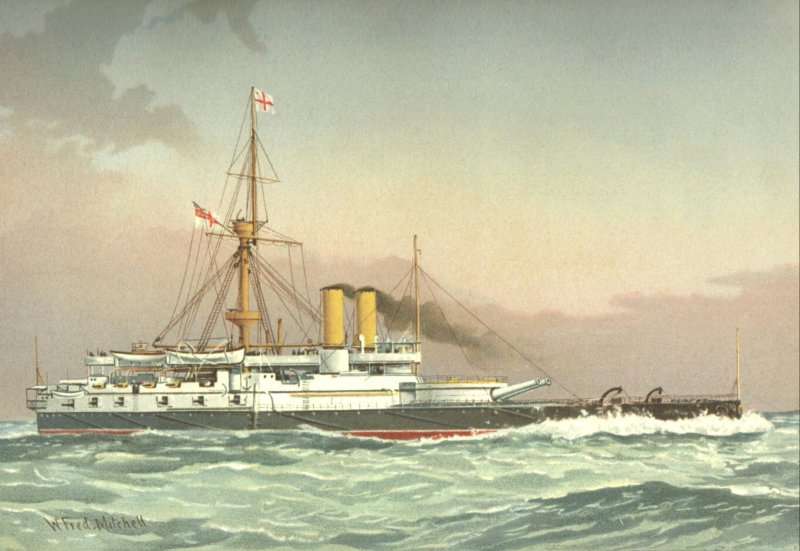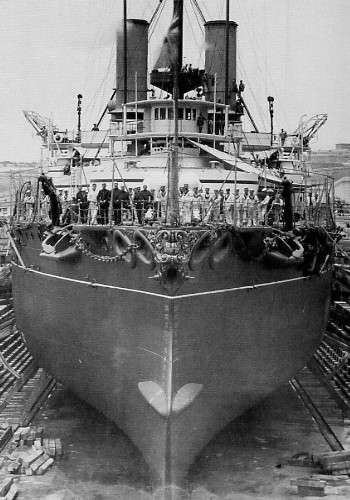HMS Victoria, launched in 1887, was a prominent battleship in the British Royal Navy. She served in the Mediterranean Fleet until a 1893 collision near Tripoli caused her sinking.

Her legacy underscores the challenges of naval command and the unpredictability of the sea.
Design Of HMS Victoria
HMS Victoria was built at the Armstrong shipyards in Elswick, Newcastle upon Tyne. She was first laid down on the 13 June 1885, launched on 9 April 1887 and then finally commissioned in March 1890.
HMS Victoria was an imposing figure on the waters. She had a length of approximately 340 feet (104 meters) and a beam, or width, of about 70 feet (21 meters). Her draft, was roughly 27 feet (8.2 meters). These dimensions made her one of the larger battleships of her era.
 HMS Victoria in a drydock in Malta, 1888.
HMS Victoria in a drydock in Malta, 1888.
The most distinctive feature of HMS Victoria was its turret, which was positioned forward of the ship and housed two monstrous 16.25-inch Mk I guns.
This was a significant deviation from contemporary warship designs, which usually favored multiple gun turrets.
 The huge forward turret on HMS Victoria.
The huge forward turret on HMS Victoria.
The choice to equip the battleship with these mammoth guns was strategic; their sheer size and power meant that the ship could deliver unparalleled firepower in naval skirmishes.
Such a concentrated artillery design was a gamble in some respects, as it focused much of the ship’s offensive capabilities into a singular, forward-pointing direction.
Service History
Upon her completion, the HMS Victoria immediately became an integral part of the Royal Navy’s strategic assets.
Her service, primarily with the Mediterranean Fleet, reflected the geopolitical dynamics of the era and underscored the Navy’s commitment to maintaining a dominant presence in this critical maritime region.
The Mediterranean Sea, historically a cradle of ancient civilizations, had in the modern era become a hotspot for imperial ambitions and strategic maneuvering among European powers.
By stationing the HMS Victoria in the Mediterranean, the British Empire was reinforcing its strategic interests, ensuring the safety of trade routes, and displaying its naval strength to rival nations.
 HMS Victoria on the River Tyne.
HMS Victoria on the River Tyne.
The mere presence of such a state-of-the-art battleship in these waters was a clear demonstration of British commitment to its allies in the region and a warning to potential adversaries about the Empire’s readiness to defend its interests.
Under various captains, including the notable Sir George Tryon, HMS Victoria took part in a range of operations. Apart from the usual patrols aimed at deterring piracy and safeguarding commercial ships, the ship also engaged in joint exercises with other vessels in the fleet.
The Collision At Tripoli
On June 22, 1893, a serene day in the Mediterranean was disrupted by an unforeseen naval disaster off the coast of Tripoli. The event revolved around a critical maneuver ordered by Vice-Admiral Sir George Tryon, a maneuver that would result in the tragic sinking of HMS Victoria.
The Mediterranean Fleet was undergoing tactical exercises. These exercises were designed to simulate real battle conditions, testing the fleet’s coordination, responsiveness, and strategic decision-making. The fleet was divided into two columns of ships, with each column moving parallel to the other.
Vice-Admiral Tryon, aiming to demonstrate a tactical reversal of the fleet’s direction, ordered both columns to turn inwards towards each other simultaneously.
The objective was for the two columns to execute the turn and then slip past each other’s rear, effectively reversing direction while maintaining formation.
Unfortunately, there seemed to be a grievous error in the estimation of the distance required for such a move.
As the two lead ships – HMS Victoria and HMS Camperdown – began their inward turns, it became distressingly clear that they were on a direct collision course.
The crews aboard both battleships hurriedly attempted to rectify the situation as the looming danger became apparent, but the momentum and sheer size of these vessels made rapid course corrections virtually impossible.
 A drawing of the ship.
A drawing of the ship.
Within moments, the bow of HMS Camperdown rammed into the starboard side of HMS Victoria. The force of the collision was so intense that it tore a gargantuan hole into Victoria, compromising her structural integrity.
The damage was catastrophic, causing water to rush into the wounded battleship at an alarming rate.
The immediate aftermath of the collision was chaotic. HMS Victoria, suffering from the significant breach in her side and rapidly taking on water, began to tilt perilously.
Within just a few minutes, she capsized and sank, taking with her over 350 officers and crew members, including the fleet’s commanding officer, Vice-Admiral Tryon.
Which HMS Ship Sank?
On December 10, 1941, two British warships (the battlecruiser HMS Repulse and the battleship HMS Prince of Wales) sank near the east coast of Malaysia. These ships were central elements of Force Z, which had the mission of intercepting a Japanese invasion fleet.
Aftermath Of The HMS Victoria Tragedy
Immediately following the incident, there were urgent calls for an inquiry.
The Royal Navy, known for its discipline and precision, had to explain how such a grave miscalculation had occurred under its watch.
The subsequent court-martial laid much of the blame on Vice-Admiral Tryon’s shoulders for his fateful order.
After a decade-long search, the wreckage was finally located on 22 August 2004 at a depth of 140 metres (460 ft) by the collaborative efforts of Lebanese-Austrian diver Christian Francis and British diver Mark Ellyatt.
Surprisingly, the ship rests vertically, with her bow and approximately 30 metres of the ship embedded in the seabed, while her stern points directly upward.
This orientation, initially believed to be unique, is also observed in the wreckage of the Russian monitor Rusalka.
The ship’s distinctive position is hypothesized to be a result of the heavy forward turret housing the main armament, combined with the momentum from her still-spinning propellers pushing the wreck downward.
News
A Creative Journey: Lady Gaga’s Artistic Growth and Fearless Embrace of Individuality
The weirdness and craziness of star Lady Gaga’s outfits have been increasing every day. Even if she were dressed in rags and beggar clothes, no one would be surprised. Lady Gaga created her own unique, shocking fashion line that no…
Gaga’s Street Style: No Bras, Semi-Sheer Top, and Daring Daisy Dukes in NYC
Lady Gaga recently unveiled the much-anticipated track list for her latest album, Joanne, and she is certainly not shying away from the limelight. The singer was spotted in New York on Saturday confidently flaunting her unique fashion sense. Her daring…
VIDEO : Unexpected Flashback: Old Footage Resurfaces Showing Lady Gaga’s Unusual On-Stage Act with a Girl Vomiting on Her Chest
It’s come back up. A clip of a woman making herself vomit on Lady Gaga during her SXSW performance in 2014 has resurfaced online — and the bile hasn’t aged well. Gaga, 36, incorporated performance artist Millie Brown into her choreography…
My First Piano Teacher Was a Stripper’: Lady Gaga Reveals Dad Hired a Stripper as Her Music Teacher, Linking it to Her Signature Long Nails
Lady Gaga is one of the popular artists who’s known for image reinventions and musical versatility. She rose to fame with her debut studio album, The Fame in 2007 with its chart-topping singles Just Dance and Poker Face. She is not only…
20 Bizarre Photos Prove That Lady Gaga Is The Most Unhinged Fashion Icon Ever
One of the most iconic and multi-talented artists of our time, Lady Gaga, with worldwide hits such as Bad Romance, Judas, and Born This Way, is also known as a composer, an actress, and above all, a fashionista. Known as…
Lady Gaga Goes Makeup-Free for Oscars Performance, Letting People See the Real Her
Oscars executive producer reveals Lady Gaga decided to go makeup-free during her performance to show people the ‘real’ her. Featured Image Credit: ABC Yesterday (March 13), the musician stunned viewers with a performance of the Oscar-nominated song ‘Hold My Hand’…
End of content
No more pages to load











